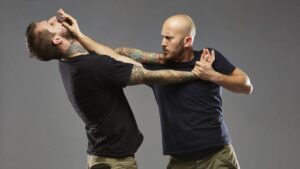 Krav Maga is made to be simple. Any sound tactical system with a worthy goal, such as self-defense, should be.
Krav Maga is made to be simple. Any sound tactical system with a worthy goal, such as self-defense, should be.
In a threatening situation, a person needs as few tactics as possible to protect themselves and evade danger, which are the goals of the Krav Maga practice.
Krav Maga’s history begins in the mid-1930s near Bratislava, Czechoslovakia, where antisemitism endangered the lives of the Jewish population. Imi Lichtenfeld, a Hungary-born fighter, led a team of wrestlers and boxers to protect the Jews from the Nazi regime.
Litchtenfeld understood the difference between competition and street fighting and recognized that traditional fighting was insufficient. Thus began the Krav Maga martial arts practice as a clinically designed self-defense method.
The name Krav Maga means “contact combat” and became the fundamental self-defense method of the IDF (Israeli Defense Force).
Mindset
Mindset is essential to good Krav Maga and good self-defense. My teacher, Eyal Yanilov, once told me that we must be able to go “from being the lamb to being the lion” as the predator already sees us as prey.
“But you must also be able to go back, or else you are a psychopath,” Yanilov went on to say.
I once asked him about a scenario in which a gunman demanded my wallet. He taught me first to realize who I am dealing with in such a scenario. “If all the gunman wants is your wallet, perhaps you should give them your wallet,” he said.
Sometimes, the imminent threat is more dangerous, so we must adjust our mindset based on the aggressor. Sometimes, fighting is the best option, and sometimes it is not. Remember, there are no medals. The only objective is to get home alive.
Five Principles of Krav Maga
- Identify and remove the immediate threat.
- Have a simultaneous and violent counterattack.
- Control the weapon.
- Counterattack as necessary (until the threat is neutralized).
- Disengage and assess.
EDITOR’S NOTE: Stephen J. Del Castillo is a Krav Maga Grand Master and Founding Master Instructor of Krav Maga Martial Arts (KMMA) school in Lutz, Florida.